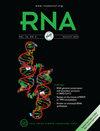Regulation of the Drosophila transcriptome by Pumilio and the CCR4-NOT deadenylase complex
IF 4.2
3区 生物学
Q2 BIOCHEMISTRY & MOLECULAR BIOLOGY
引用次数: 0
Abstract
The sequence-specific RNA-binding protein Pumilio controls Drosophila development; however, the network of mRNAs that it regulates remains incompletely characterized. In this study, we utilize knockdown and knockout approaches coupled with RNA-Seq to measure the impact of Pumilio on the transcriptome of Drosophila cells in culture. We also use an improved RNA co-immunoprecipitation method to identify Pumilio-bound mRNAs in Drosophila embryos. Integration of these datasets with the locations of Pumilio binding motifs across the transcriptome reveal novel direct Pumilio target genes involved in neural, muscle, wing, and germ cell development, and cellular proliferation. These genes include components of Wnt, TGF-beta, MAPK/ERK, and Notch signaling pathways, DNA replication, and lipid metabolism. We identify the mRNAs regulated by the CCR4-NOT deadenylase complex, a key factor in Pumilio-mediated repression, and observe concordant regulation of Pumilio:CCR4-NOT target mRNAs. Computational modeling reveals that Pumilio binding, binding site number, clustering, and sequence context are important determinants of regulation. In contrast, we show that the responses of direct mRNA targets to Pumilio-mediated repression are not influenced by their content of optimal synonymous codons. Moreover, contrary to a prevailing model, we do not detect a role for CCR4-NOT in the degradation of mRNAs with low codon optimality. Together, the results of this work provide new insights into the Pumilio regulatory network and mechanisms, and the parameters that influence the efficacy of Pumilio-mediated regulation.Pumilio和CCR4-NOT死酶复合体对果蝇转录组的调控
序列特异性 RNA 结合蛋白 Pumilio 控制着果蝇的发育;然而,它所调控的 mRNA 网络仍未完全定性。在这项研究中,我们利用基因敲除和基因剔除方法以及 RNA-Seq 技术来测量 Pumilio 对果蝇培养细胞转录组的影响。我们还使用一种改进的 RNA 共沉淀方法来鉴定果蝇胚胎中与 Pumilio 结合的 mRNA。将这些数据集与整个转录组中 Pumilio 结合基序的位置进行整合,发现了新的 Pumilio 直接靶基因,这些基因参与了神经、肌肉、翅膀和生殖细胞的发育以及细胞增殖。这些基因包括 Wnt、TGF-beta、MAPK/ERK 和 Notch 信号通路、DNA 复制和脂质代谢的组成成分。我们确定了受 CCR4-NOT 脱氨酶复合物调控的 mRNA,该复合物是 Pumilio 介导的抑制作用的关键因素,我们还观察到 Pumilio:CCR4-NOT 目标 mRNA 的一致调控。计算模型显示,Pumilio 的结合、结合位点数量、聚类和序列上下文是调控的重要决定因素。相反,我们发现直接 mRNA 靶标对 Pumilio 介导的抑制的反应并不受最佳同义密码子含量的影响。此外,与流行的模型相反,我们没有发现 CCR4-NOT 在低同义密码子优化的 mRNA 降解中发挥作用。总之,这项工作的结果为了解 Pumilio 的调控网络和机制以及影响 Pumilio 介导的调控效果的参数提供了新的视角。
本文章由计算机程序翻译,如有差异,请以英文原文为准。
求助全文
约1分钟内获得全文
求助全文
来源期刊

RNA
生物-生化与分子生物学
CiteScore
8.30
自引率
2.20%
发文量
101
审稿时长
2.6 months
期刊介绍:
RNA is a monthly journal which provides rapid publication of significant original research in all areas of RNA structure and function in eukaryotic, prokaryotic, and viral systems. It covers a broad range of subjects in RNA research, including: structural analysis by biochemical or biophysical means; mRNA structure, function and biogenesis; alternative processing: cis-acting elements and trans-acting factors; ribosome structure and function; translational control; RNA catalysis; tRNA structure, function, biogenesis and identity; RNA editing; rRNA structure, function and biogenesis; RNA transport and localization; regulatory RNAs; large and small RNP structure, function and biogenesis; viral RNA metabolism; RNA stability and turnover; in vitro evolution; and RNA chemistry.
 求助内容:
求助内容: 应助结果提醒方式:
应助结果提醒方式:


